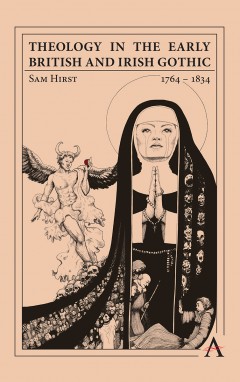Theology in the Early British and Irish Gothic, 1764–1834
By Sam Hirst
Other Formats Available:
- About This Book
- Reviews
- Author Information
- Series
- Table of Contents
- Links
- Podcasts
About This Book
Theology in the Early British and Irish Gothic, 1764–1832 seeks to explore the extent to which Early British Gothic writing, c.1760–1830, took distinctive shape in the particular theological and theo-political climate of the late eighteenth and early nineteenth centuries. The project takes as its starting point the widely noted ‘anti-Catholicism’ of the Early British Gothic. While taking into account the existing work in this field, the thesis will move beyond a simplistic Protestant/Catholic binary found in works, such as Diane Long Hoeveler’s The Gothic Ideology (2014) and Maria Purves Gothic and Catholicism (2009), which investigate the Gothic as anti- or pro-Catholic respectively. The project also moves the almost exclusively Anglican focus of texts like Alison Millbank’s God and the Gothic (2018), instead placing the Gothic within the complex theo-political context of tolerance debates, focused not only on Anglican-Catholic relations but on the place and suppression of Protestant Dissent. Having established the contemporary context of a proliferation of Dissenting denominations, the lack of a unified Anglican positions, the rich field of theological debate in the period and the continuing importance of Christianity (in its various forms) as a lived religion in the period, the project seeks to investigate the way in which varied theologies underpin key tropes, aesthetics and debates within the Gothic.
Theology in the Early British and Irish Gothic, 1764–1832 seeks to explore works throughout the period of the efflorescence and decline of the Early British Gothic, mapping changing currents and trends in the theo-aesthetics of the genre and its depiction and engagement with various supernatural phenomena. It seeks to investigate not only major writers of the period, such as Ann Radcliffe and Matthew Lewis, but a selection of writers from different denominational backgrounds in order to investigate the ways in which contemporary theological debates can be traced across Gothic texts of the period and the ways in which different theological positions manifest in these texts.
Reviews
‘In this excellent study, Sam Hirst meticulously explores the theological underpinnings of a broad range of early British and Irish Gothic fictions. As rigorously researched as it is elegantly written, the volume convincingly shows, in the end, how we ignore the Gothic’s abiding theological contexts and concerns to our peril.’ —Dale Townshend, Professor of Gothic Literature, Manchester Centre for Gothic Studies, Manchester Metropolitan University, UK.
‘Through intellectually nuanced and refined engagement with contemporary religious discourse and literary analysis, Hirst’s book reframes the Gothic as a theologically inflected genre. The book brings a refreshing, novel and much-needed perspective to Gothic studies and provides a critical stepping stone in the field of Gothic literature and theology.’—Madeline Potter, University of York, UK.
‘Theology in the Early British and Irish Gothic, 1764–1834 charts new trajectories for a subject that is important to our understanding of the Gothic. Through a series of thematically organised chapters on toleration, the sublime, theorising the demonic sublime, dreams and ghosts, Hirst’s study promises to be an important intervention in the field of Gothic theology.’ —Angela Wright, University of Sheffield, UK.
Hirst's new book is a valuable piece of scholarship, both for its much-needed challenge to longstanding critical assumptions, and for its lively and thought-provoking discussions of the religious underpinnings of Gothic’s many nightmares. - Irish University Review
This marvellous book is indispensable for anybody working on early Gothic, and is also of immense benefit to those working on more recent work, thanks to the brilliant way it questions longstanding assumptions. It takes propositions that we habitually take for granted – that early Gothic was secular and anti-Catholic – and complicates them in striking, meaningful and intellectually rigorous ways. - Sara Wasson, Chair of the International Gothic Association’s Allan Lloyd Smith Prize
This book is a substantial contribution to a growing body of gothic criticism that (finally) takes the theological seriously. Eighteenth-Century Fiction
Author Information
Sam Hirst completed a PhD in the theology of the Early British Gothic at Manchester Metropolitan University. Sam Hirst is an honorary research fellow at the University of Liverpool, a research fellow at the University of Nottingham and a lecturer in the nineteenth century at Oxford Brookes University. Sam Hirst runs the online education project ‘Romancing the Gothic,’ which provides access to live and recorded talks on subjects related to Gothic and horror from experts around the world and facilitates an annual conference.
Series
Anthem Studies in Gothic Literature
Table of Contents
Introduction; Chapter 1: “Christ is not Divided”: Theologies of Toleration and the Depiction of the Catholic; Chapter 2: “Serve the Lord with Fear and Rejoicing”: Gothic Theologies of the Sublime; Chapter 3: “For Satan Himself is Transformed into an Angel of Light”: The Theo-Aesthetics of Demonic Depiction; Chapter 4: “Your Sons and Daughters will Prophesie”: Gothic Dreams; Chapter 5: “Test the Spirits”: Ghosts and Apparitions of the Gothic; Chapter 6: “If Ye Live After the Flesh, Ye Shall Die”: Embodied Immortality and Damnation; Conclusion.
Links
Stay Updated
Information
Latest Tweets



